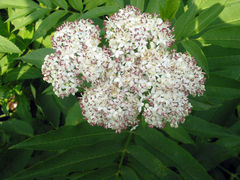Sambucus ebulus: Difference between revisions
Created page with '{{SPlantbox |familia=Caprifoliaceae |genus=Sambucus |species=ebulus |common_name=Dane's elder, �Danewort, Dwarf elder |name_ref=Flora - A Gardener's Encyclopedia |habit=herbac…' |
No edit summary |
||
| Line 1: | Line 1: | ||
{{SPlantbox | {{SPlantbox | ||
|familia=Caprifoliaceae | |familia=Caprifoliaceae | ||
|genus=Sambucus | |genus=Sambucus | ||
|species=ebulus | |species=ebulus | ||
|common_name=Dane's elder, | |taxo_author=L. | ||
|common_name=Dane's elder, Danewort, Dwarf elder | |||
|name_ref=Flora - A Gardener's Encyclopedia | |name_ref=Flora - A Gardener's Encyclopedia | ||
|habit=herbaceous | |habit=herbaceous | ||
| Line 28: | Line 29: | ||
|usda_ref=Flora - A Gardener's Encyclopedia | |usda_ref=Flora - A Gardener's Encyclopedia | ||
|max_zone=10 | |max_zone=10 | ||
|image= | |image=Sambucus nigra flori bgiu.jpg | ||
|image_width=240 | |image_width=240 | ||
|image_caption=Danewort inflorescence | |||
}} | }} | ||
'''Danewort''' (''Sambucus ebulus''), also known as '''Dane Weed''', '''Danesblood''', '''Dwarf Elder''' or '''European Dwarf Elder''' and '''Walewort'''<ref name="Westwood, Jennifer 1985 p. 103">Westwood, Jennifer (1985). ''Albion. A Guide to Legendary Britain''. London : Grafton Books. ISBN 0-246-11789-3. p. 103.</ref> is a [[herbaceous]] species of [[Elderberry|elder]], native to southern and central [[Europe]] and southwest [[Asia]]. It grows to 1-2 m tall, with erect, usually unbranched stems growing in large groups from an extensive perennial underground [[rhizome]]. The [[leaf|leaves]] are opposite, pinnate, 15-30 cm long, with 5-9 leaflets with a foetid smell. The stems terminate in a [[corymb]] 10-15 cm diameter with numerous white (occasionally pink) [[flower]]s. The [[fruit]] is a small glossy black [[berry]] 5-6 mm diameter. The ripe fruit give out a purple juice.<ref name="Westwood, Jennifer 1985 p. 103" /> | |||
The name Danewort comes from the belief that it only grows on the sites of battles that involved the [[Danes (Germanic tribe)|Dane]]s.<ref name="Westwood, Jennifer 1985 p. 103" /> The term 'Walewort' or 'Walwort' meant 'foreigner plant.' The plant's stems and leaves turn red in autumn and this may explain the link with blood. The word Dane may link to an old term for diarrhoea.<ref name="Westwood, Jennifer 1985 p. 103" /> | |||
==Cultivation== | ==Cultivation== | ||
| Line 48: | Line 52: | ||
<gallery perrow=5> | <gallery perrow=5> | ||
Image:SambucusEdulus-Ripe.jpg|Dwarf Elder berries | |||
Image:Upload.png| photo 1 | Image:Upload.png| photo 1 | ||
Image:Upload.png| photo 2 | Image:Upload.png| photo 2 | ||
Latest revision as of 23:38, 10 May 2010
| Sambucus ebulus subsp. var. | Dane's elder, Danewort, Dwarf elder | |||||||||||||||||||||||||||||||||||||||||||||||||||||||
|---|---|---|---|---|---|---|---|---|---|---|---|---|---|---|---|---|---|---|---|---|---|---|---|---|---|---|---|---|---|---|---|---|---|---|---|---|---|---|---|---|---|---|---|---|---|---|---|---|---|---|---|---|---|---|---|---|

|
|
| ||||||||||||||||||||||||||||||||||||||||||||||||||||||
| ||||||||||||||||||||||||||||||||||||||||||||||||||||||||
Danewort (Sambucus ebulus), also known as Dane Weed, Danesblood, Dwarf Elder or European Dwarf Elder and Walewort[1] is a herbaceous species of elder, native to southern and central Europe and southwest Asia. It grows to 1-2 m tall, with erect, usually unbranched stems growing in large groups from an extensive perennial underground rhizome. The leaves are opposite, pinnate, 15-30 cm long, with 5-9 leaflets with a foetid smell. The stems terminate in a corymb 10-15 cm diameter with numerous white (occasionally pink) flowers. The fruit is a small glossy black berry 5-6 mm diameter. The ripe fruit give out a purple juice.[1]
The name Danewort comes from the belief that it only grows on the sites of battles that involved the Danes.[1] The term 'Walewort' or 'Walwort' meant 'foreigner plant.' The plant's stems and leaves turn red in autumn and this may explain the link with blood. The word Dane may link to an old term for diarrhoea.[1]
Cultivation
Propagation
Pests and diseases
Varieties
Gallery
-
Dwarf Elder berries
-
photo 1
-
photo 2
-
photo 3
References
External links
- w:Sambucus ebulus. Some of the material on this page may be from Wikipedia, under the Creative Commons license.
- Sambucus ebulus QR Code (Size 50, 100, 200, 500)

